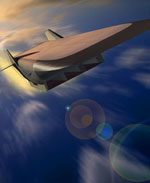
Image credit: NASA
NASA has picked Allied Aerospace to continue the development of its X-34C experimental aircraft. The $150 million contract will have Allied create three flight-ready demonstrator vehicles that will fly more than 8,000 kilometres per hour; or seven times the speed of sound. The vehicle is intended to demonstrate a working scramjet engine, which pulls part of its fuel from the air – making it smaller and more efficient. The demonstration aircraft will be launched atop a Pegasus rocked and raised to Mach 5; then they’ll disengage and speed up to Mach 7 under their own power.
NASA has selected Allied Aerospace Industries of Tullahoma, Tenn., to provide three flight-ready experimental demonstrator vehicles that will fly approximately 5,000 miles per hour or seven times the speed of sound. The multi-year project, called X-43C, will expand the hypersonic flight envelope for air-breathing engines.
The cost-plus-fixed-fee completion type contract carries performance incentives and is valued at nearly $150 million over 66 months. The base activity covers all work through completion of the Preliminary Design Review, and the optional effort covers the final design, hardware fabrication and all associated support activities.
The X-43C is the next logical step, following the Hyper-X (X-43A), vehicle that aims at demonstrating short duration scramjet powered flight at Mach 7 and Mach 10. The X-43C will demonstrate free flight of a scramjet-powered vehicle with acceleration capability from Mach 5 to Mach 7, as well as operation of a hydrocarbon fuel-cooled scramjet.
NASA’s Langley Research Center (LaRC), Hampton, Va. is leading a combined U.S. Air Force/industry team in the design and development of the X-43C demonstrator vehicle and its propulsion system. The engine, which will be provided by the Air Force, will be a dual-mode scramjet capable of running as a ramjet or scramjet.
Allied Aerospace, Flight Systems Division, will team with Pratt & Whitney, West Palm Beach, Fla.; Boeing Phantom Works, Huntington Beach, Calif.; and RJK Technologies, Blacksburg, Va.
Work will be performed primarily in Tullahoma and West Palm Beach. Some contract work will also take place at Huntington Beach, Blacksburg, St. Louis, LaRC and NASA’s Dryden Flight Research Center (DFRC), Edwards, Calif.
Future air-breathing space access vehicles offer advantages over conventional rocket-powered vehicles that must carry all of the oxidizer needed to burn their fuel. Air-breathing engine-powered vehicles obtain oxygen from the atmosphere in flight. By minimizing the need to carry oxidizer, smaller and more efficient vehicles can be designed for space access missions.
‘When fully developed, these advanced propulsion systems will offer increased safety, payload capacity and economy of operation for future, reusable space access vehicles,” said Paul Moses, manager of the X-43C project. “The X-43C project will validate advanced technologies, design tools and test techniques that will enable design of such vehicles in the future,” he said.
For the three demonstration flights, a Pegasus-derived rocket booster will be air-launched by a carrier aircraft to boost the X-43C demonstrator vehicles to Mach 5 at approximately 80,000 feet. The X-43C will separate from the booster and continue to accelerate to Mach 7 under its own power and autonomous control.
Flights will originate from DFRC. Flight paths of the vehicles will be over water within the Pacific Test Range.
Original Source: NASA News Release
